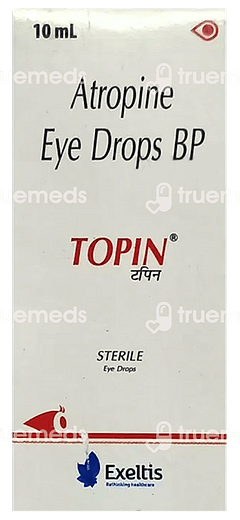Atropine + Chlorbutol
Uses of Atropine + Chlorbutol
Atropine + Chlorbutol is primarily used for diagnostic and therapeutic procedures in ophthalmology and belongs to the category of anticholinergic agents.
It is also utilized for the management of amblyopia in children when combined with patching the good eye.
Side effects of Atropine + Chlorbutol
Sensitivity to light
Blurred vision
Stinging or burning sensation in the eye
Dry mouth
Tachycardia
How Atropine + Chlorbutol works
- Atropine + Chlorbutol is an ophthalmic combination.
- Atropine, one of the major components, is an anticholinergic agent. It blocks the action of a neurotransmitter called acetylcholine, reducing muscle spasms and secretions within the body. In the eye, it paralyzes the muscles that control lens shape and pupil size, causing pupil dilation and a temporary inability to focus on near objects.
- The other component, Chlorobutol, primarily acts as a preservative to prevent microbial growth in the solution. It also has mild local anesthetic properties and provides weak antibacterial benefits.
Certified content
Written By

BDS, MDS
Reviewed By

BMS, FMC, MD Resident
Expert Advice
Dosage Forms Available
- Atropine + Chlorbutol is available as an ophthalmic solution or eye drops.
- It is a sterile solution, which is generally clear and colorless to slightly yellow.
- This formulation is designed to be administered directly into the eyes.
Age and Dose Restrictions
- Atropine + Chlorbutol eye drops are suitable for use by both adults and children, with specific doses and frequencies of application being determined by a doctor based on the patient's age, medical condition, and response to treatment.
Contraindications
- Atropine + Chlorbutol is contraindicated in patients with known hypersensitivity to atropine, chlorobutanol, or any other component of the formulation.
- It is also not recommended for patients with angle-closure glaucoma or adhesions between the iris and lens (synechiae).
Other Medications to Avoid
- Atropine + Chlorbutol may interact with other anticholinergic agents (such as scopolamine), topical anesthetics (like lidocaine), and antimicrobial agents (such as neomycin). These interactions can potentially enhance side effects like dryness, irritation, or delayed healing in treated areas.
Overdose and Missed Dose
- Overdose of Atropine + Chlorbutol can lead to symptoms such as fever, dry skin and mucous membranes, rapid heart rate (tachycardia), confusion, hallucinations, restlessness, and even coma in severe cases. If you suspect an overdose, inform your doctor immediately.
- If a dose of this medication is missed, it should be administered as soon as you remember. However, if it is close to the time for the next dose, skip the missed dose and resume your regular dosing schedule.
Management of Side Effects
Most side effects of Atropine + Chlorbutol are temporary and tend to resolve after discontinuing the medicine. However, severe side effects or worsening symptoms should warrant immediate consultation with a doctor.
- Drinking plenty of fluids may help manage dry mouth.
- Wearing sunglasses can help manage sensitivity to light, a potential side effect due to pupillary dilation.
- Rest and relaxation techniques may help manage any mild sedative effects from chlorobutanol.
Use in Driving and Operating Machinery
- Use of Atropine + Chlorbutol may cause blurred vision and light sensitivity due to pupillary dilation. These effects may impair your ability to drive or operate heavy machinery.
Use in Pregnancy and Lactation
- Atropine + Chlorbutol should only be used during pregnancy or lactation if the potential benefits outweigh the risks, as determined by a doctor.
Caution in Other Conditions
- Patients with Down's syndrome, spastic paralysis, or brain damage, who are more prone to atropine toxicity, should use Atropine + Chlorbutol with caution.
Special Dietary and Lifestyle Recommendations
- Maintain good eye hygiene to prevent infection or irritation when using eye drops.
- Regular check-ups with an ophthalmologist can help monitor progress and manage potential side effects effectively.
- Avoid direct sunlight or bright light, which can increase discomfort from pupillary dilation caused by atropine.
Frequently asked questions
Can Atropine + Chlorbutol cause any allergic reactions?
Yes, Atropine + Chlorbutol can cause allergic reactions. Symptoms may include rash, itching, swelling, severe dizziness, and trouble breathing. If you experience any of these symptoms, contact your doctor immediately.
Can I use Atropine + Chlorbutol for redness and swelling in the eyes?
Atropine + Chlorbutol is not typically used to manage eye redness or swelling. It is primarily used for diagnostic and therapeutic procedures in ophthalmology. Consult your doctor for the appropriate treatment for redness and swelling in the eyes.
How does Atropine + Chlorbutol work?
Atropine relaxes the muscles of the eye to dilate the pupil, while Chlorbutol acts as a preservative and mild antiseptic to maintain the sterility of the solution.
Can Atropine + Chlorbutol affect my mood or cause changes in behaviour?
Atropine, one of the active ingredients in this combination, can cross the blood-brain barrier and thus, in rare cases, may cause effects on mood or behavior, including confusion or agitation. If you experience such symptoms, contact your doctor immediately.
Can Atropine + Chlorbutol be used for dry eyes?
No, Atropine + Chlorbutol is not typically used for managing dry eyes. Its primary use is for diagnostic and therapeutic procedures in ophthalmology. If you have dry eyes, please consult your doctor for appropriate treatment options.
Are there any natural alternatives to Atropine + Chlorbutol?
There are no known natural alternatives that have the same effects as Atropine + Chlorbutol. Always consult your doctor before trying any alternative remedies.
How long does Atropine + Chlorbutol stay in the body?
The half-life of chlorobutanol, one of the active ingredients in this combination, is about 1 to 2 days. However, the exact time it takes for Atropine + Chlorbutol to be eliminated from the body can vary depending on several factors like metabolism and dosage. Consult your doctor for more specific information.
List of Medicines for Atropine + Chlorbutol
-1--EYE-DROPS-10-ML_1.webp?width=240)

Company
About UsHealth ArticleHealth StoriesDiseases & Health ConditionsAll MedicinesAll BrandsNeed HelpFAQSubscribe
Registered Office Address
Grievance Officer
Download Truemeds

Contact Us
Our customer representative team is available 7 days a week from 9 am - 9 pm.
v3.7.8
Our Payment Partners








